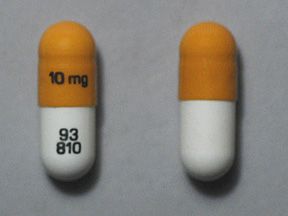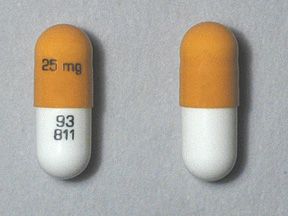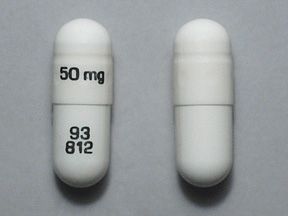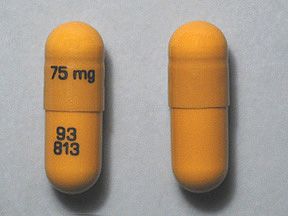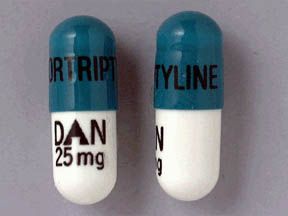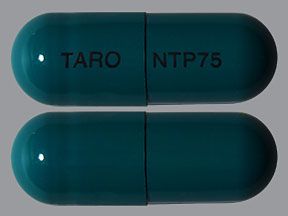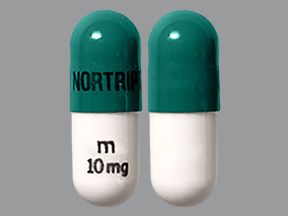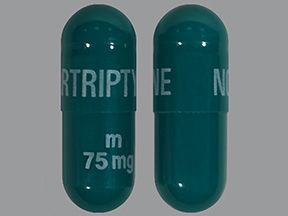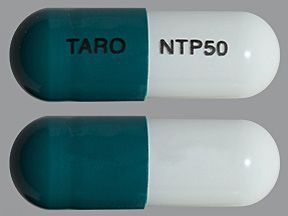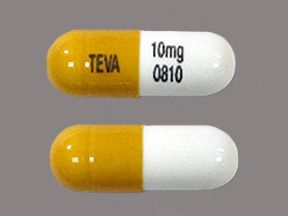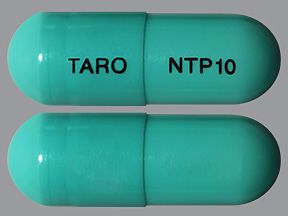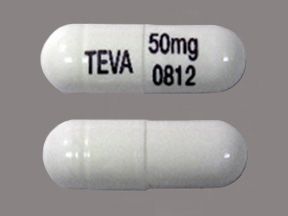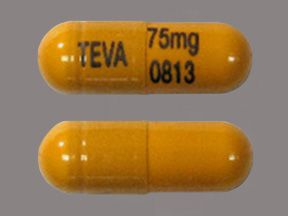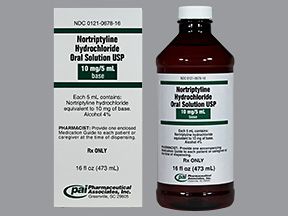Key takeaways
- Nortriptyline is a generic drug approved to treat depression, and it can be prescribed for other off-label uses.
- Common side effects of nortriptyline include low or high blood pressure, confusion, sleep problems, and dry mouth.
- The dosage of nortriptyline varies based on factors such as how severe your depression is, how treatment affects you, and your age.
- Boxed warning: Nortriptyline has a boxed warning about an increased risk of suicidal thoughts and behaviors in people younger than 24 years old. Boxed warnings are the most serious warnings from the Food and Drug Administration (FDA). See “What should be considered before taking nortriptyline?” for details.
- Cardiovascular problems warning: Taking nortriptyline could put you at risk of a fast heart rate, heart attack, stroke, and other circulatory problems. Tell your doctor if you have any heart problems before taking nortriptyline. They won’t prescribe nortriptyline if you recently had a heart attack.
- Increased eye pressure warning: Nortriptyline may increase the pressure in your eyes. This may cause glaucoma in people who are already at risk of glaucoma, such as if you’re over 60 years old or you have a family history of glaucoma.
- Serotonin syndrome warning: This drug may cause a condition called serotonin syndrome, which refers to having a high level of the chemical serotonin in the body. See “Nortriptyline side effects” for details and symptoms.
- Dementia warning: Research has indicated that tricyclic antidepressants such as nortriptyline can cause effects similar to those caused by drugs called anticholinergics. This can raise your risk of dementia.
Nortriptyline is prescribed to treat depression in adults, by itself or with other medications. It comes as an oral capsule and an oral solution. This article focuses on the capsules.
Doctors may also prescribe nortriptyline off-label for other conditions, such as premenstrual dysphoric disorder or diabetic nerve pain. (Off-label drug use means prescribing a drug for a purpose other than what it’s been approved for by the Food and Drug Administration [FDA].)
Nortriptyline oral capsules are also available as the brand-name drug Pamelor. Nortriptyline is a generic drug, which means it’s an exact copy of the active ingredient in a brand-name medication. Generic drugs are thought to be as safe and effective as the brand-name drug they’re based on.
How nortriptyline works
Nortriptyline belongs to a class of drugs called tricyclic antidepressants. The drug works on your central nervous system to increase the levels of certain chemicals in your brain. This can help relieve depression symptoms.
Like most drugs, nortriptyline may cause mild to serious side effects. The following lists describe some of the more common side effects that nortriptyline may cause. These lists don’t include all possible side effects.
More common side effects
Some of the more common side effects that can occur with use of nortriptyline include:
- low or high blood pressure
- confusion (mainly in older adults)
- sleep problems
- shakiness
- dry mouth
- blurry vision
- skin side effects, such as:
- rash or hives
- itching
- skin sensitivity to light
- gastrointestinal side effects, such as:
- nausea, vomiting, or diarrhea
- abdominal cramps
- constipation
- decreased libido (sexual desire)
- unexpected weight loss or gain
- sweating
- headache
If these effects are mild, they may go away within a few days or a couple of weeks. If they’re more severe or don’t go away, talk with your doctor or pharmacist.
This is a partial list of side effects. You can talk with your doctor or pharmacist, or read nortriptyline’s prescribing information to learn more.
Serious side effects
Call your doctor right away if you have serious side effects. Call 911 if your symptoms feel life threatening or if you think you’re having a medical emergency. Serious side effects and their symptoms can include the following:
- Mood or behavioral changes, such as:
- worsening depression
- increased risk of suicidal thoughts and behaviors in people younger than 24 years old (nortriptyline has a boxed warning about this; see “Important warnings” at the beginning of this article for details)
- anxiety
- restlessness
- panic attacks
- sleep disturbances such as nightmares or insomnia (trouble sleeping)
- disorientation
- rapid speech and increased activity (which can be signs of mania in some cases)
- Fast heart rate.
- Heart attack. Symptoms can include:
- chest pain
- shortness of breath
- pain or pressure in your upper body
- Stroke. Symptoms can include:
- weakness in one part or side of your body
- slurred speech or trouble speaking
- Inability to urinate.
- Seizures.
- Serotonin syndrome. Symptoms can include:
- shakiness
- agitation
- nausea and vomiting
- sweating
- changes in blood pressure
- fast heart rate
- loss of consciousness
- muscle tremors or stiff muscles
- Increased eye pressure. Symptoms can include:
- eye pain
- swelling and skin discoloration near your eyes
- vision changes
ALLERGIC REACTIONFor some people, nortriptyline can cause an allergic reaction. In general, symptoms of allergic reaction can be mild or serious.
What might help
If you have mild symptoms of an allergic reaction, such as a mild rash, call your doctor right away. They may suggest a treatment to manage your symptoms and can determine whether you should keep taking nortriptyline.
If you have symptoms of a severe allergic reaction, such as swelling or trouble breathing, call 911 or your local emergency number right away. These symptoms could be life threatening and require immediate medical care.
If your doctor confirms you’ve had a serious allergic reaction to nortriptyline, they may have you switch to a different treatment.
This dosage information is for nortriptyline oral capsule. All possible dosages and drug forms may not be included here. Your dosage, drug form, and how often you take the drug will depend on:
- your age
- the condition being treated
- how severe your condition is
- other medical conditions you have
- how the medication affects you, such as any side effects you have
Forms and strengths
Nortriptyline comes as an oral capsule and an oral solution. This article focuses on the capsules, which come in the following strengths:
- 10 milligrams (mg)
- 25 mg
- 50 mg
- 75 mg
Brand: Pamelor
- Form: oral capsule
- Strengths: 10 mg, 25 mg, 50 mg, 75 mg
Dosage for depression
Nortriptyline’s recommended dosage for depression is 25 mg taken three or four times per day, or all taken as one daily dose.
In adults over 65 years old and younger than 24 years old, nortriptyline’s recommended dosage is 30 to 50 mg total per day. A doctor may prescribe it as multiple doses or one daily dose.
Your doctor will start you on a low dose and gradually increase your dose as needed. The maximum daily dose is 150 mg.
How to take
You should swallow nortriptyline capsules whole. Do not cut or crush the capsules.
Nortriptyline may make your skin more sensitive to the sun. Be sure to use sunscreen or wear protective clothing to help prevent sunburn.
Your doctor will explain how you should take nortriptyline. They’ll also explain how much to take and how often. Be sure to follow their instructions.
Your doctor will monitor you for side effects while you take nortriptyline. Your doctor may also monitor the level of nortriptyline in your blood and your symptoms of depression.
Questions about taking nortriptyline
- Is there a best time of day to take nortriptyline? Nortriptyline can be taken at any time(s) of day, but it’s best to take it around the same time(s) each day, on a consistent schedule. This helps keep a steady level of the drug in your body, which helps nortriptyline work effectively.
- What if I miss a dose of nortriptyline? If you miss a dose of nortriptyline, take it as soon as you remember. But if it’s almost time to take your next dose, skip the missed dose and take the next dose at its usual time. You should not take two doses at once to make up for a missed dose. Doing so could raise your risk of side effects.
- Will I need to take nortriptyline long term? Nortriptyline is typically used as a long-term treatment. If you and your doctor determine that it’s safe and effective for your condition, you’ll likely take it long term.
- How to tell if nortriptyline is working: Your symptoms of depression should reduce or become easier to manage. It may take a month of treatment before you notice that your depression is easing.
Overdose
Do not take more nortriptyline than your doctor prescribes, as this can lead to harmful effects. Symptoms of a nortriptyline overdose can include:
- irregular heart rhythm
- very low blood pressure
- seizure
Call your doctor if you think you’ve taken too much nortriptyline. You can also call 800-222-1222 to reach America’s Poison Centers or use its online resource. But if you have severe symptoms, immediately call 911 or your local emergency number. Or go to the nearest emergency room.
This section contains important information you should consider before taking nortriptyline.
Interactions
Taking a medication with certain vaccines, foods, and other things can affect how the medication works. These effects are called interactions.
Nortriptyline capsules can interact with other medications, vitamins, or herbs you may be taking.
Before taking nortriptyline, talk with your doctor and pharmacist. Tell them about all prescription, over-the-counter, and other drugs you take. Also, tell them about any herbs or vitamins and supplements you use. Sharing this information can help you avoid potential interactions.
Drug interactions
This section contains a list of medications that can interact with nortriptyline. This list does not contain all drugs that may interact with nortriptyline. If you have questions about drug interactions that may affect you, ask your doctor or pharmacist.
| Drug group or drug name | Drug examples |
| monoamine oxidase inhibitors (MAOIs) and drugs with MAOI effects | • phenelzine (Nardil), tranylcypromine (Parnate), selegiline (Emsam), methylene blue |
| drugs with anticholinergic effects | • diphenhydramine (Benadryl), loratadine (Claritin), oxybutynin, solifenacin (Vesicare), olanzapine (Zyprexa) |
| cytochrome P450 2D6 inhibitors | • quinidine, sertraline (Zoloft), paroxetine (Paxil), fluoxetine (Prozac) |
| sympathomimetic drugs | • epinephrine, ephedrine, norepinephrine |
| selective serotonin reuptake inhibitors | • escitalopram (Lexapro), citalopram (Celexa), vilazodone (Viibryd) |
| selective norepinephrine reuptake inhibitors | • duloxetine (Cymbalta), desvenlafaxine (Pristiq), venlafaxine (Effexor XR) |
| triptans | • sumatriptan (Imitrex), naratriptan |
| fentanyl | – |
| lithium | – |
| tryptophan | – |
| buspirone (Buspar) | – |
| cimetidine | – |
Nortriptyline and alcohol
Excessive alcohol consumption with nortriptyline can cause or worsen suicidal thoughts and behaviors and increase the risk of a nortriptyline overdose.
If you drink alcohol, talk with your doctor about how much, if any, may be safe to consume during nortriptyline treatment.
Other interactions
Nortriptyline is known to interact with the herbal supplement St. John’s wort. These two together can increase your risk of serotonin syndrome. If you take this supplement, talk with your doctor about whether you can continue taking it with nortriptyline.
Boxed warning
Nortriptyline has a boxed warning. Boxed warnings are the most serious warnings from the Food and Drug Administration (FDA). They alert doctors and patients about drug effects that may be dangerous.
Nortriptyline may increase the risk of suicidal thoughts and behavior in people younger than 24 years old. Your doctor will monitor you for any changes in your depression symptoms and any unusual behavior or thoughts about suicide. If you’re comfortable doing so, you could ask a close friend or family member to also look out for any changes in your behavior.
Other warnings
Nortriptyline can sometimes cause harmful effects in people who have certain conditions. This is known as a drug-condition interaction. Other factors may also affect whether nortriptyline is a good treatment option for you.
Talk with your doctor about your health history before you take nortriptyline. Be sure to tell them if any of the following factors apply to you:
- history of suicidal thoughts or behaviors
- heart or cardiovascular problems, especially any history of heart attack
- bipolar disorder
- glaucoma or increased eye pressure
- urinary retention (trouble fully emptying your bladder)
- high thyroid hormone levels or use of thyroid medication
- history of seizures
- previous allergic reaction to nortriptyline
- pregnancy or breastfeeding (see the following section)
Help is out there
If you or someone you know is in crisis and considering suicide or self-harm, please seek support:
- Call or text the 988 Suicide and Crisis Lifeline at 988 or chat at 988lifeline.org. Caring counselors are available to listen and provide free and confidential support 24/7.
- Text HOME to the Crisis Text Line at 741741 to connect with a volunteer crisis counselor for free and confidential support 24/7.
- Not in the United States? Find a helpline in your country with Befrienders Worldwide.
- Call 911 or your local emergency services number if you feel safe to do so.
If you’re calling on behalf of someone else, stay with them until help arrives. You may remove weapons or substances that can cause harm if you can do so safely.
If you’re not in the same household, stay on the phone with them until help arrives.
Pregnancy and breastfeeding
It’s unclear whether nortriptyline is safe to use during pregnancy or while breastfeeding. Talk with your doctor if you’re pregnant, breastfeeding, or planning either. This drug should be used only if the potential benefits justify the potential risks.
Your doctor can recommend other depression treatments or other safe feeding options for your child if needed.
Whether you have health insurance or not, cost may be a factor when you’re considering nortriptyline. What you’ll pay for nortriptyline may depend on several things, such as your treatment plan and the pharmacy you use.
Here are a few things to consider regarding cost:
- Cost information and savings coupons: You can visit Optum Perks to get price estimates of what you’d pay for nortriptyline when using coupons from the site. See the following coupon options. (Note: Optum Perks coupons cannot be used with any insurance copays or benefits.)
- Financial support: If you have questions about how to pay for your prescription, talk with your doctor or pharmacist. If you need financial support to pay for nortriptyline, consider looking into websites that offer cost resources and information. Two such websites are:
Learn more about saving on your prescriptions.
There are other drugs available to treat depression. Some may be better suited to you than others. Talk with your doctor about other drug options that may work for you.
The following drugs are also used to treat depression, and are in a different drug class than nortriptyline:
- fluoxetine (Prozac)
- sertraline (Zoloft)
- duloxetine (Cymbalta)
You should store nortriptyline at room temperature between 68°F and 77°F (20°C and 25°C). Do not store the capsules in moist or damp areas, such as bathrooms.
When traveling with your medication:
- Always carry your medication with you. When flying, never put it into a checked bag. Keep it in your carry-on bag.
- Don’t worry about airport X-ray machines. They can’t damage your medication.
- You may need to show airport staff the pharmacy label for your medication. Always carry the original prescription-labeled container with you.
- Do not put this medication in a car’s glove compartment or leave it in a car. Be sure to avoid doing this particularly when the weather is very hot or very cold.
Disclaimer: Healthline has made every effort to make certain that all information is factually correct, comprehensive, and up to date. However, this article should not be used as a substitute for the knowledge and expertise of a licensed healthcare professional. You should always consult your doctor or other healthcare professional before taking any medication. The drug information contained herein is subject to change and is not intended to cover all possible uses, directions, precautions, warnings, drug interactions, allergic reactions, or adverse effects. The absence of warnings or other information for a given drug does not indicate that the drug or drug combination is safe, effective, or appropriate for all patients or all specific uses.





